When a Minneapolis police officer murdered George Floyd last year, the video of his killing immediately ricocheted around the web. The massive social movement that followed may have been the largest in U.S. history. Millions took to the streets and the internet to express a desire for racial justice in the United States, in a movement that has become encapsulated by the viral hashtag #BlackLivesMatter.
But a year after Floyd’s killing many observers have begun to ask what—if anything—has fundamentally changed? These questions are in part about the possibility of racial equality and real police reform in America, but also address the extent to which a political and social movement with online origins can break into the U.S. mainstream and effect real change. In the year since Floyd’s murder, online interest in Black Lives Matter has steadily grown. An analysis of more than 50 million Twitter posts between Jan. 28, 2013 and April 30, 2021 finds that the outpouring of online support for #BlackLivesMatter following Floyd’s killing resulted in a lasting shift and a more vocal and engaged online public, with no evidence of hashtag cooptation by more conservative users over the past year. While the Black Lives Matter movement’s impact on the policy landscape remains uncertain, its online presence is undoubtedly stronger.
The growth of a hashtag movement
On July 13, 2013, George Zimmerman was acquitted of all charges in the fatal shooting of Trayvon Martin. Immediately, several Twitter users aired their disappointment and reminded the world of a simple truth: Black Lives Matter. Their tweets marked some of the first uses of a hashtag that would enter the mainstream a year later, on November 25, 2014, when a grand jury declined to indict Darren Wilson in the fatal shooting of Michael Brown—and protesters online and off turned to the #BlackLivesMatter hashtag to express their anger and grief. As police violence has persisted and the movement for racial justice continues, the #BlackLivesMatter hashtag has emerged as an enduring feature of online discourse. As of April 30, 2021, it has been used in more than 25 million original Twitter posts, which collectively have garnered approximately 444 billion likes, retweets, comments, or quotes—roughly 17,000 engagements per post.[1]
Since Floyd’s murder, this online activism has only accelerated. In the seven days between his death on May 25, 2020, and the police attack on protesters in Lafayette Square on June 1, the #BlackLivesMatter hashtag generated approximately 3.4 million original posts with 69 billion engagements—or roughly 13% of all posts and 15.5% of all engagements on Twitter in that period. #BlackLivesMatter content peaked on June 8, with some 1.2 million original posts mentioning the hashtag. This marked an astonishing increase in use of the hashtag: Prior to the June protests, the record for posts had been July 8, 2016, following the deaths of Alton Sterling and Philando Castile, when original content reached 145,631 posts with an average of 7.4 engagements per post.
Figure 1 plots this dramatic increase in use of the #BlackLivesMatter hashtag, alongside markers of milestones in the movement. Following Floyd’s murder, posts increased exponentially and previous spikes in content barely register in comparison. The figure also plots use of #BlueLivesMatter, a hashtag movement expressing support for the police and that, here, illustrates the disparity in interest between the two hashtags. Between 2013 and 2021, #BlueLivesMatter has registered 1.6 million original posts and 1.7 billion engagements (about 1,000 per post), which while smaller in scope than #BlackLivesMatter, is not insignificant. Use of the two hashtag movements appear to rise and fall together.
Figure 1: Total Original #BlackLivesMatter and #BlueLivesMatter Posts
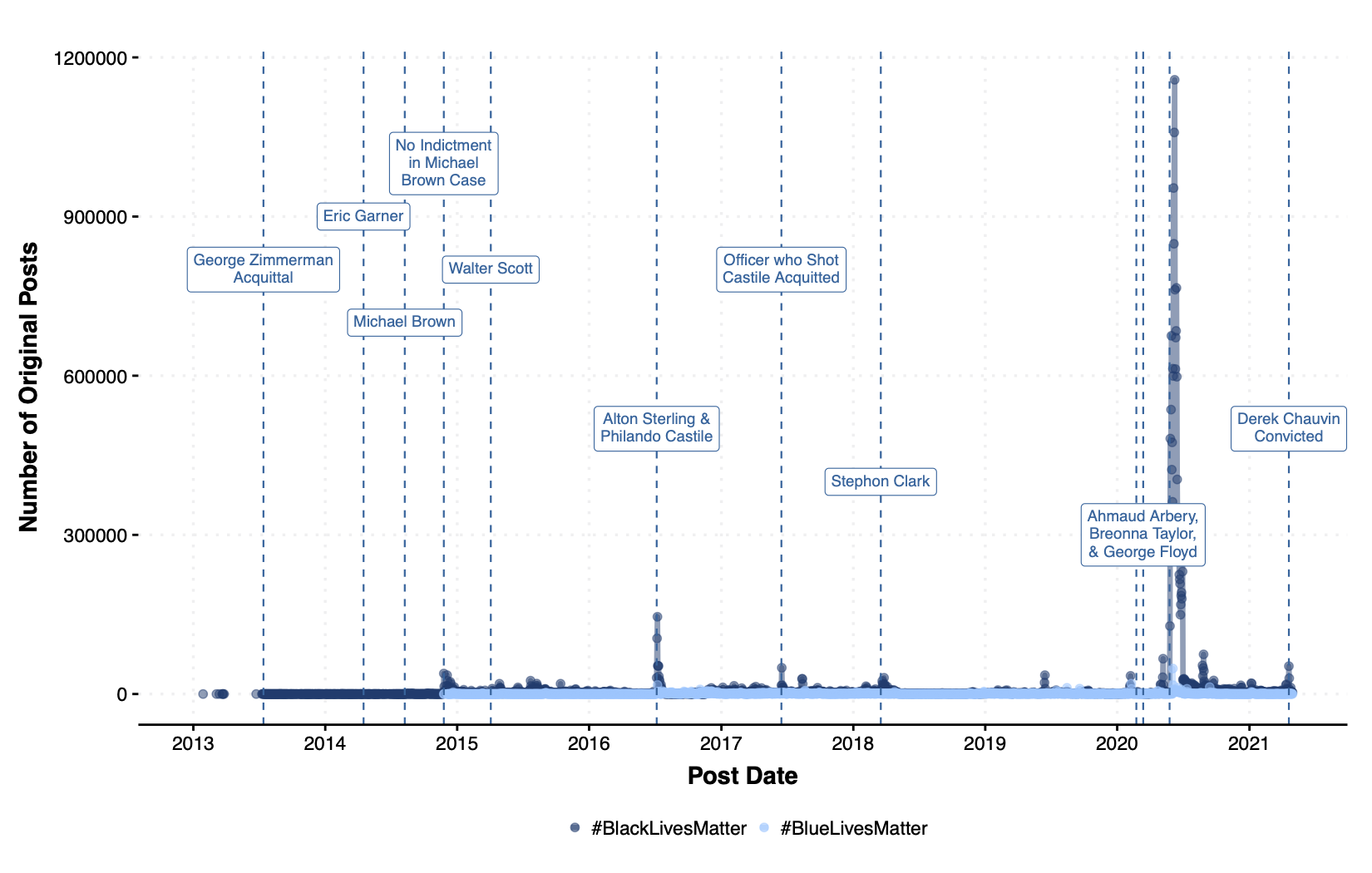
After George Floyd
The basic time series detailed above highlights how atypical last summer’s social media discourse was surrounding #BlackLivesMatter. But the skewed nature of the data masks underlying patterns. Though it may not be immediately apparent, Floyd’s murder marked a turning point in Twitter conversations around #BlackLivesMatter. By transforming the data to a log-scale, the steady growth of a movement (and separation from a countermovement) becomes clear (Figure 2). This type of transformation is particularly useful on highly skewed data. Visually, the log transformation represents data as a percentage change, such that going from 1 to 2 will appear the same on a graph as going from 100 to 200, even though the absolute change in value (1 vs. 100) differs.
Figure 2: Total Original #BlackLivesMatter and #BlueLivesMatter Posts (Logged)
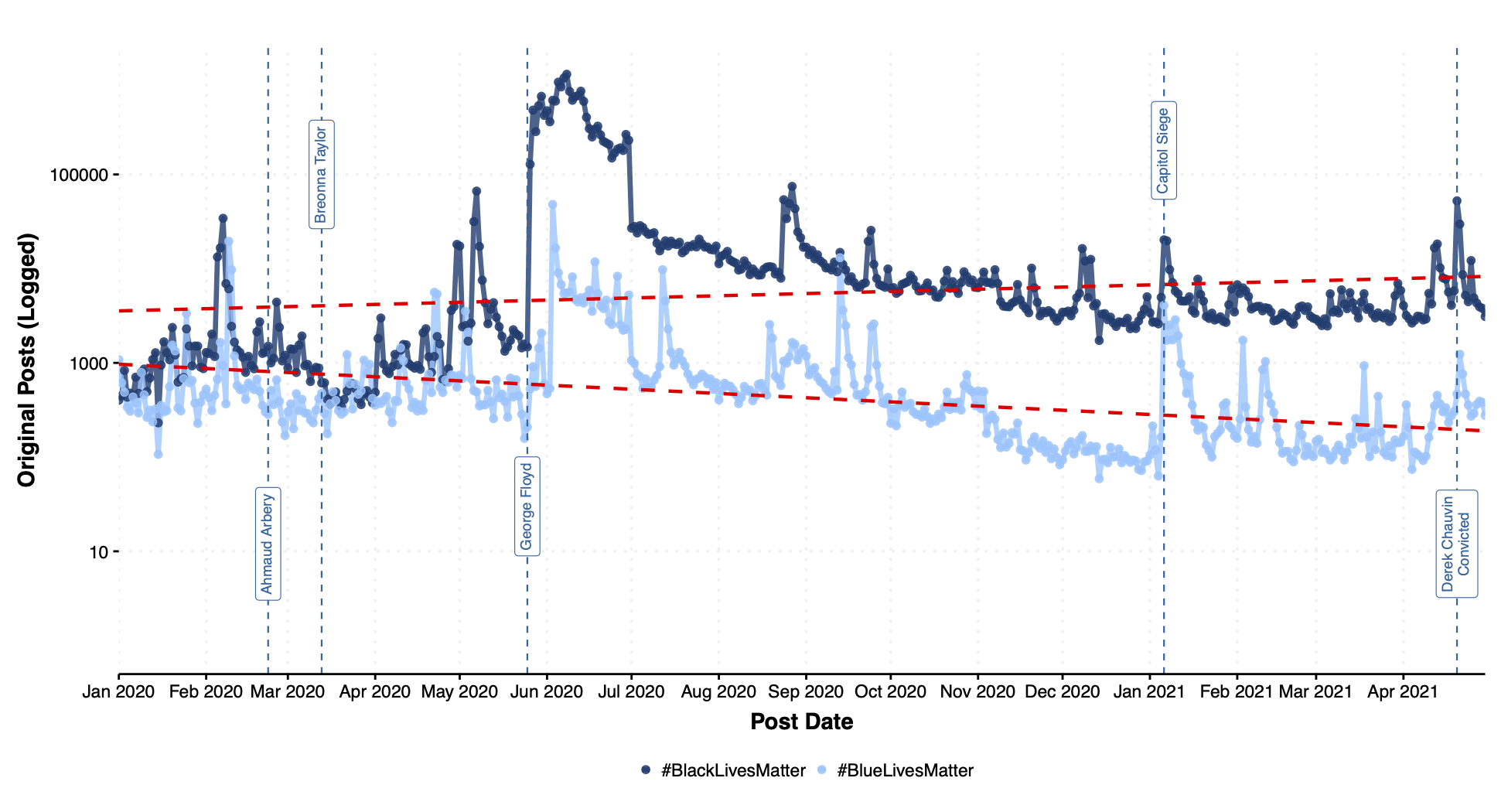
In the run-up to Floyd’s murder, #BlackLivesMatter and #BlueLivesMatter content tracked together, rising and falling in response to instances of police violence. But Floyd’s murder breaks this pattern: Both #BlackLivesMatter and #BlueLivesMatter content surge, but the former does not return to its pre-Floyd “normal.” #BlueLivesMatter content declines steadily in the subsequent months after the initial spike, but #BlackLivesMatter content rises relative to the time prior to Floyd’s murder. Between January 1 and March 31, 2020, the average daily number of original posts for #BlackLivesMatter and #BlueLivesMatter content was 1,829 and 836 respectively. During this same period in 2021, these numbers stand at 4,368 and 394 respectively. This represents a nearly 250% increase in #BlackLivesMatter content on the year, a sizable—and seemingly durable—shift.
Hashtag cooptation
Over the years, the overlapping spikes in #BlackLivesMatter and #BlueLivesMatter content have sparked intense rhetorical competition online among Twitter users. As a result, the sustained growth in #BlackLivesMatter content might be dismissed as a case of hashtag cooptation, in which the movement’s opponents ironically or negatively post using the hashtag. But by examining the expanded network of users sharing content, it is evident that this is not the case. Figures 3 and 4 plot the average political ideology of Twitter accounts using the #BlackLivesMatter and #BlueLivesMatter hashtags at two contentious political moments over the past year—the January 6 assault on the U.S. Capitol and the Derek Chauvin trial.[2]
Until early January, the political ideology of these users was as we would expect it—users sharing the #BlackLivesMatter hashtag more liberal, users sharing the #BlueLivesMatter hashtag more conservative. Then, the ideology of users sharing the #BlueLivesMatter hashtag becomes dramatically more liberal for a brief period of time. This is likely due to an ironic appropriation of the hashtag in response to the Capitol assault, which resulted in one police officer dying and many more being injured. By contrast, the steady ideological score associated with posts that used the #BlackLivesMatter hashtag suggests that content during this period was driven by users supportive of the hashtag’s message.
Figure 3: Average Political Ideology of #BlackLivesMatter and #BlueLivesMatter Hashtag Users
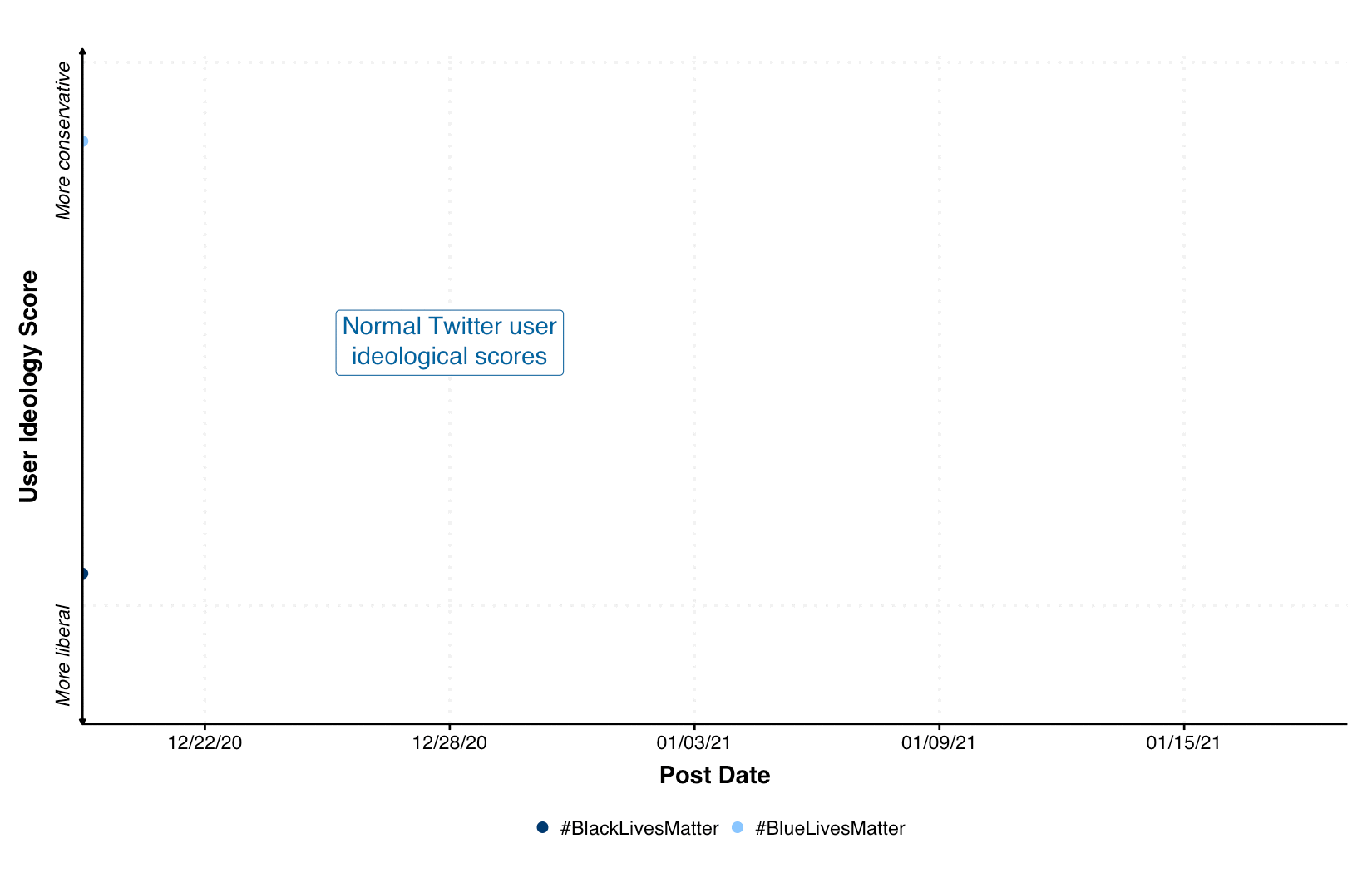
The political ideology of users posting #BlackLivesMatter and #BlueLivesMatter has held steady during other periods of upheaval, indicating that it is unlikely that hashtag cooptation is causing a significant portion of the growth in use of the #BlackLivesMatter hashtag. Over the course of April, a police officer shot and killed Daunte Wright during a traffic stop in Brooklyn Center, Minnesota, while former police officer Derek Chauvin stood trial nearby for Floyd’s murder. Figure 4 shows that, as in January, the average ideology of users posting content with the #BlackLivesMatter hashtag barely fluctuated. Unlike in January, however, the average ideology of #BlueLivesMatter hashtag users did not change. Instead, what registers is an online battle for control of the #AllLivesMatter hashtag, which fluctuates wildly over the course of the month in ways that coincide with Wright’s killing and Chauvin’s conviction.
Figure 4: Average Political Ideology of #BlackLivesMatter, #BlueLivesMatter, and #AllLivesMatter Hashtag Users
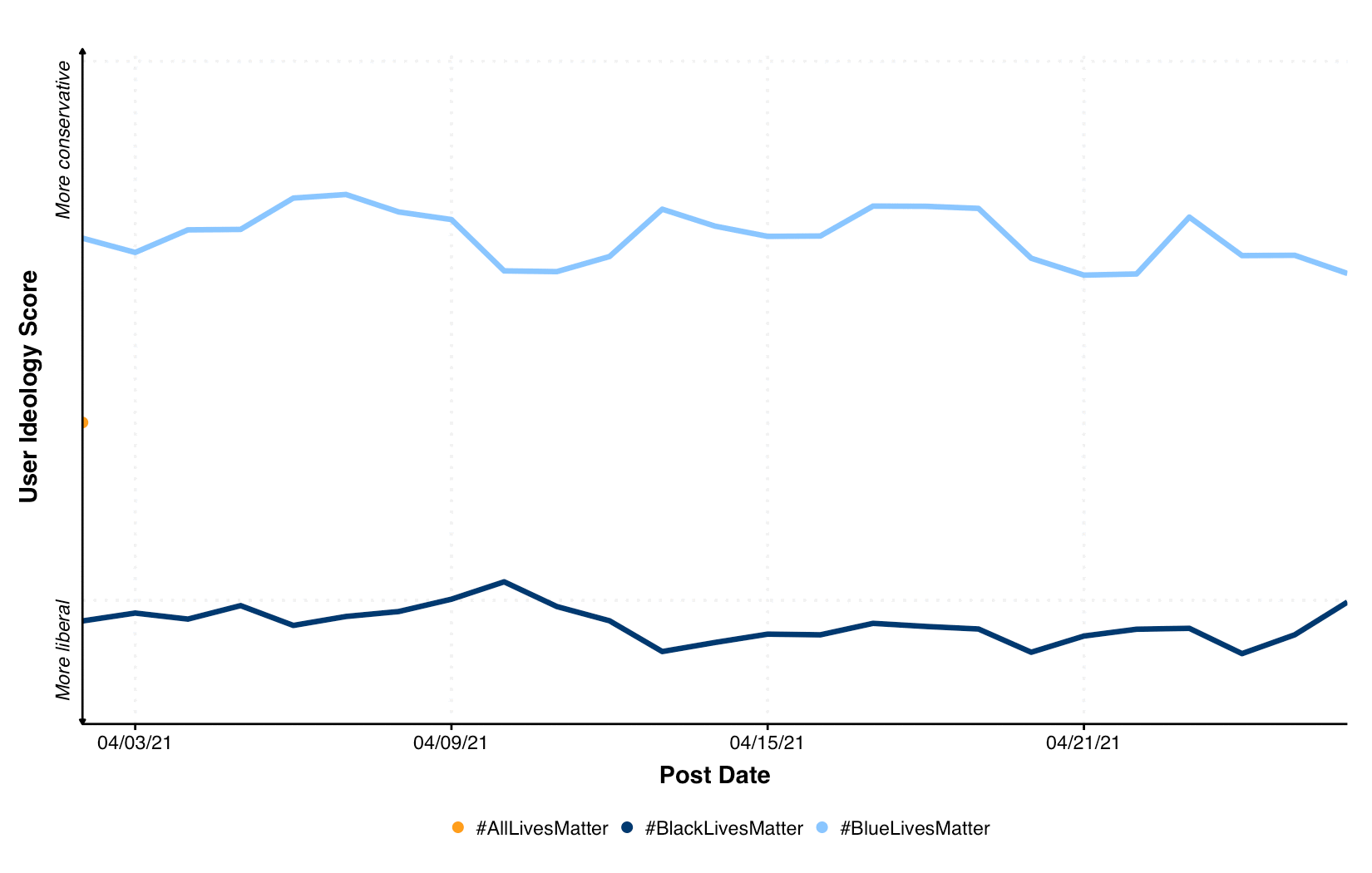
Conclusion
While support for the Black Lives Matter movement has declined in recent months, particularly in conservative America, there remains a steady interest in this online conversation. A growing number of users are actively engaged both during and outside the times of intense interest associated with moments of upheaval. For a social and political movement bolstered by a hashtag, this growth may serve as a silver lining to a challenging year. The difficulty, of course, is translating online activism—commonly critiqued as slacktivism—into offline political change. Yet some research has found that online support can translate to meaningful offline action. And this may be particularly true of young people, who unsurprisingly are disproportionately represented in online political conversations. This may be somewhat less difficult for #BlackLivesMatter, which began, in part, as a social media conversation and has now firmly entered the political mainstream.
Valerie Wirtschafter is a senior data analyst in the Artificial Intelligence and Emerging Technologies Initiative at the Brookings Institution and a Ph.D. candidate in the Department of Political Science at the University of California, Los Angeles.
[1] In this analysis, I exclude retweets, which are counted as observations in some analyses. Instead, retweets are included in “engagements,” which also includes likes, comments, and quote tweets. Data for this analysis from January 2013 to June 2020 comes from Giorgi, et al. (2020), which due to Twitter’s terms of service, provides only posts ids for approximately 41 million tweets that reference #BlackLivesMatter, #BlueLivesMatter or #AllLivesMatter. I use the rehydratoR package in R to pull the Twitter content from the post ids provided. Finally, I use the Twitter API to pull the remaining posts from July 2020 through April 2021. Twitter post IDs for this expanded dataset can be made available on request.
[2] In his 2015 Political Analysis paper, Pablo Barberá develops a strategy for calculating the partisan ideology of Twitter users, based on the network of Twitter users they chose to follow. The idea is that the decision to follow certain elites is a “signal” of political interest, which can then be used as an input to determine the partisan preferences of a given Twitter user. This estimation strategy aligns well with other common measures of ideology, including party registration records and DW-NOMINATE scores. Given that these calculations are data intensive and Twitter API rate limits for this content are fairly restrictive, I utilize this strategy but restrict my analysis to users who shared relevant content over a given time period that received at least fifty likes, retweets, comments or quotes. In order to ensure the precision of ideology estimates, I also exclude users who follow fewer than five “elites.” Elites include politicians, media outlets, think tanks, political commentators, and other influential Twitter users. Positive scores are more conservative and negative scores are more liberal. More details on the methodology and implementation can be found here.

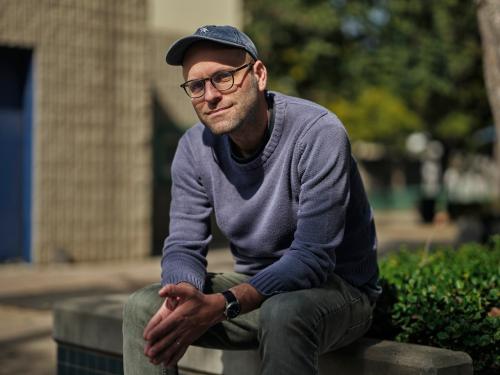
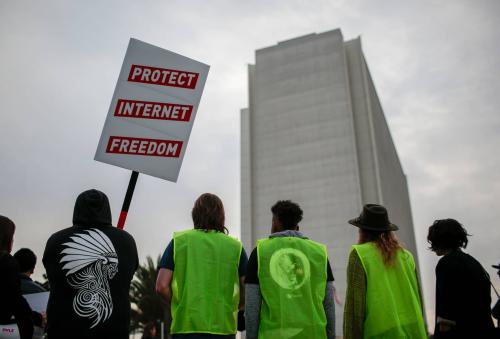
Commentary
How George Floyd changed the online conversation around BLM
June 17, 2021